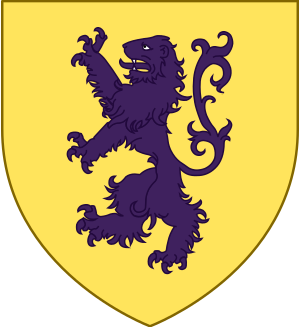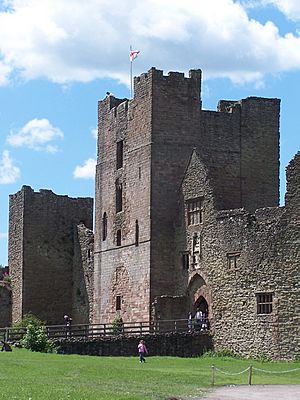Roger de Lacy facts for kids
Roger de Lacy was an important Anglo-Norman nobleman who lived a long time ago. He was known as a Marcher Lord, which meant he controlled lands along the border with Wales. Roger was also famous for building castles, especially Ludlow Castle. He passed away sometime after the year 1106.
Contents
Who Was Roger de Lacy?
Roger de Lacy was a powerful figure in England after the Normans took over. He was part of a noble family. His job as a Marcher Lord was to protect the border between England and Wales. This was a very important role because there were often conflicts in that area.
What Lands Did Roger de Lacy Own?
Roger inherited many lands from his father, Walter de Lacy. These included places like Castle Frome in Herefordshire. A very old record called the Domesday Survey from 1086 shows that Roger also owned other important places. These included Ocle Pychard, Almeley Castle, and Eardisley Castle. He also held Icomb Place and Edgeworth Manor.
Roger had some control over a place called Ewias Lacy. Today, this is known as Longtown Castle near the Welsh border. Another place, Stanton Lacy, likely became his after his father's death. His main strong base was at Weobley. Roger held these lands directly from the King, which made him very powerful. He even owned parts of salt-making businesses in Droitwich.
Roger de Lacy's Rebellions
Roger de Lacy was involved in some big disagreements with the King. He was known for being a "rebel baron." This means he sometimes went against the King's wishes.
The Rebellion of 1088
In 1088, Roger joined a rebellion against William Rufus. William Rufus was the King of England at that time. Roger worked with other local lords like Osbern fitzRichard and Ralf of Mortemer. They tried to challenge the King's power.
The Conspiracy of 1095
Later, in 1095, Roger was linked to another plan against King William. Because of his involvement, he was sent away from England. This was a common punishment for powerful nobles who rebelled against the King.
What Happened to Roger's Family?
After Roger de Lacy was exiled, his lands faced some changes. His important stronghold of Weobley went to his brother, Hugh de Lacy. Hugh passed away before 1115. After Hugh's death, the de Lacy lands were given to another person named Pain fitzJohn.
Roger's son, Gilbert de Lacy, worked very hard to get back the family's lands. He especially focused on getting back the holdings at Longtown and Ludlow. This shows that even after Roger's exile, his family tried to keep their power and property.



